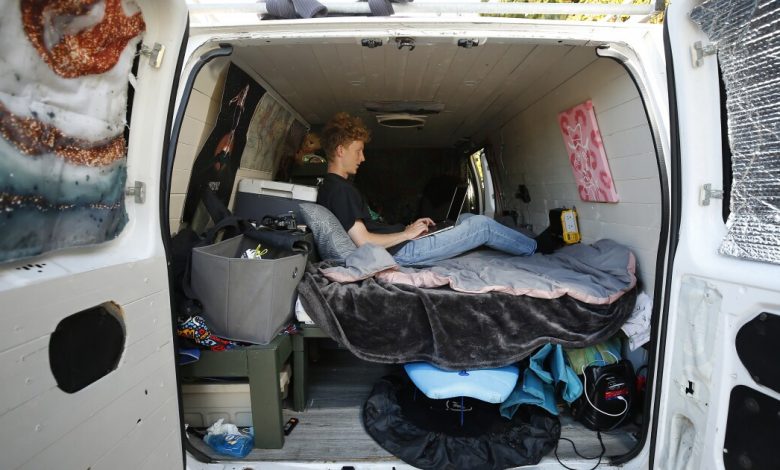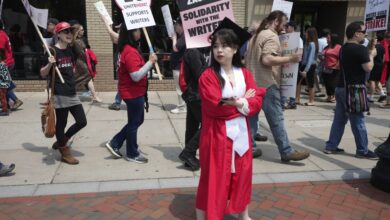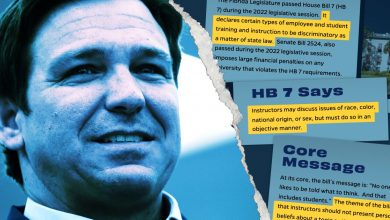California Colleges Have a Homelessness Problem. Would Monthly Payments Help?

[ad_1]
Every semester for about the last five years, Scott Myers-Lipton has learned that one to three of his students at San José State University were recently or currently are homeless.
“Sometimes I get to know it’s happening because I see their grades suffer so badly and I ask, ‘What’s going on? Why are you doing so horribly all of a sudden?’” said Myers-Lipton. “They tell me, ‘Well, I’m sleeping in my car, or I’m sleeping in the library, or I’m sleeping in the student union, or I’m couch surfing and I don’t have anywhere else to be.’ That’s how a lot of times it comes out.”
Myers-Lipton quantified the issue of student homelessness as a co-author of the Silicon Valley Pain Index, an annual report that illustrates income inequality and racial discrimination in the region. The 2020 report, the first published by the university’s Human Rights Institute, reported that over 4,000 San José State students experienced homelessness at some point in the previous year — 13.2 percent of the student body. Half of the students also reported cutting their portion sizes or even skipping meals because they couldn’t afford the cost of food.
Dismayed, Myers-Lipton turned to a policy maker in hopes of finding a way to help. David Cortese, a California state senator whose district covers a swath of Silicon Valley, suggested sending state-assistance payments of $500 a month to low-income students across California State University’s 23 campuses — an idea molded after universal basic-income programs, which have gained attention in recent years as a way to reduce poverty.
Up to 14,000 students who have a family household income of up to $20,000 could qualify for the monthly payments if the California Legislature approves the pilot program. While initial rollout of the plan would likely only include three to five campuses, Cortese said he hopes it could eventually be expanded to not only the entire California State University system but also community colleges, which have an even greater percentage of homeless students. The lawmaker says he is still working out a few things but plans to introduce the legislation formally this month.
He and Myers-Lipton hope the program will benefit the nearly 11 percent of students within the California State University system who said they experienced homelessness one or more times within a 12-month period, according to a 2018 university report. That’s about 53,000 students. More than 40 percent of survey respondents also reported experiencing food insecurity.
The numbers were even more disproportionate for Black, first-generation students, with 18 percent experiencing homelessness and about 65 percent reporting food insecurity.
Over the past few years, California politicians and community organizations have put forward plans in hopes of alleviating student homelessness. Long Beach City College launched a pilot program in 2021 that allows students to sleep in their vehicles at an on-campus parking structure. Other universities have established subsidized housing units for their students.
Unlike these programs, Cortese said, his proposal would move away from “prescriptive policies” that dictate how students should spend government aid. They would be able to choose how to spend the stipend.
While some have expressed concerns that the payments could make low-income students ineligible for federal benefits such as Pell Grants or the child tax credit, Myers-Lipton said Cortese is working to ensure this doesn’t happen.
Toni Molle, director of California State University public affairs, said administrators are in conversation with Cortese about the potential program and “look forward to continuing the dialogue on this important issue.”
“The CSU is committed to expanding financial support beyond traditional financial aid as well as removing policies and fees that inadvertently prevent students from graduating on time, and we appreciate the intent of any lawmaker who shares that same priority,” Molle said in an email.
This is not Cortese’s first foray into universal basic-income programs. He helped develop a guaranteed-income pilot program that focused on pregnant individuals and on young adults who recently left the foster-care system, which the California Legislature approved last year.
“A lot of (students) might need $500 to go toward a room or rent, but some might need $250 to cover part of their rent and $250 for food. In any given month somebody might want to buy a pair of shoes or a warm coat,” Cortese said. “If you tell them, ‘You can’t use any portion of that to empower your own decisions and satisfy your own needs,’ we are really messing with the whole hierarchy of needs and disempowering people.”
According to preliminary estimates, a three-campus plan would cost the state about $57 million, and a five-campus plan would cost about $84 million. Which campuses would see the implementation of the program has yet to be determined.
Citing the California budget’s projected surplus of $45.7 billion, Cortese feels now is the right time to move forward with the program. He said he’s yet to receive any significant pushback in his initial conversations with legislative colleagues.
“If we are trying to deal with this overwhelming homeless problem that we have right now, why wouldn’t we just allow people to start putting money in banks tomorrow? We can do that right now,” Cortese said. “We have money. They have bank accounts. It doesn’t require much more infrastructure than that.”
[ad_2]
Source link






